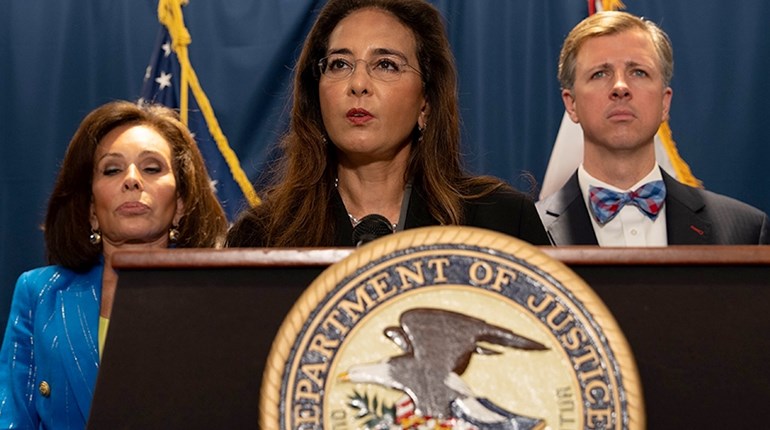
Dotted beneath the steadily warming spring sky of Southern California, a handful of locals—young and old, different ethnicities, men and women—have risen early on a Sunday morning. Despite their varying appearances and backgrounds, they have all gathered with smiles for the very same reason: They are training to shoot a firearm for the first time.
While 2020 shattered records when it came to new gun-owners, with some estimating at least five million Americans locking and loading for the very first time last year, the trend appears to be ascending even faster in 2021. U.S. gun sales in January leaped an estimated 60%, making it the highest lone month for sales since the FBI began recording background check data in 1998. More than two million firearms were sold in the three weeks preceding the inauguration, with a vast number—as per estimates from gun industry leaders and sellers—of firearms entering the hands of first-time purchasers.
Estimated sales have only continued to climb as the nation grapples with general uncertainty, the very real threat of the passage of gun control laws at both the state and federal levels, and arbitrary lockdowns amid the protracted pandemic fallout. According to the National Shooting Sports Foundation (NSSF), the majority of firearms sold over the past year were small handguns.
And within the swell of first-time buyers was a large subset of women; they accounted for an estimated 40%, or about two million of these purchases. It is believed that more Latinos, Asians, and Black Americans also bought their very first gun last year than ever before.
“Typically, we see those first-time buyers as those most-affected by crime, such as minorities and women. Many seem to be concerned about their safety and security,” said Jeff Gonzales, the Austin-based president of tactical training company, Trident Concepts. “However, I have seen another reason. This reason has more to do with independence. Through this all, I believe many have come to recognize they are on their own for many things—safety and security being big ones.”
Gonzales noted that most first-time buyers are opting for “something safe and easy to use in terms of purchases.”
“Accessories seem to be low on the priority scale compared to ammunition. Folks are abstaining from upgrades and investing in ammunition,” he said.
Subsequently, the swell of new buyers has had a dramatic impact on the way the gun industry does business.
At first, the sudden surge—coupled with pandemic-compelled closures—ignited supply chain and inventory shortages. Once at least some of those kinks were ironed out last year, sellers sought to meet higher demand, especially in the realm of 9 mm pistols.
Brian Grimes, logistics manager of the Arizona-based Elegant Arms, stressed that the accessories most requested are magazines, ammo, optics, as well as suppressors.
“The influx of first-time buyers has affected our inventory. Because of the high demand, our distribution channels have hardly any inventory for me to order. All the popular brands and models are almost impossible to get. Most of the inventory is used and consignment,” he said. “The market will stabilize eventually. But when is unknown at this time.”
In conjunction with the sales spike, so too is the soaring need for tactical training and basic firearms instruction catering to the novice shooter.
Meanwhile, Raziel Cohen, founder of the New Jersey-based NDF Training and who is known as “The Tactical Rabbi,” said that he has observed several new buyers going for AR-15s, as well as standard handguns.
“I’ve definitely changed my business model to accommodate the huge growth of firearms owners. We recently launched an online training program to help new shooters be familiar with their firearms and to ensure a safer community,” he said. “The most-important part of owning a firearm is safety. Since many new shooters don’t know where to start, this program helps them understand where to begin. The course covers everything from where to store your firearm, safety around children, and understanding which firearm is right for you.”
Gonzales also noted that he has had to start an online primary-training series, in partnership with industry brands, to further serve the new demographic of gun owners.
“We provide strategies to the students to help manage their ammunition. We give them control of what they have available for the class,” he said. “It has been very helpful, but when we have talked with these students after the class, everyone has commented how they wish they had the prescribed round count.”
And Yen Loyola, a Tampa, Fla.,-based NRA basic pistol instructor and range-safety officer for East Coast Concealed, pointed out that he has noticed “a major need from the Cuban/Spanish community” for tailored training.
“Many have a hard time with speaking English yet want to use their right to bear arms. So I have created the only Spanish CWP course in the South East,” he said. “The industry has definitely been impacted in a good way, but it has created the need for more training classes.”
While the first-time buyers come from a wide-array of walks of life and hail from all across the country, there are some common denominators: most are concerned with the gnawing feeling of instability and the need to keep themselves, and their families, safe.
With a firestorm of factors, compounded by an anti-gun administration in the White House, industry observers expect that 2021 could even top the record-breaking sales of 2020.
At the current tempo, gun sales nationwide are on track to hit almost 50 million by the year’s end.
“There has been somewhat of an awakening by many who were somewhat blasé about guns. We have moved past a trend and more towards an ideological shift,” Gonzales said. “Training and education on the rise as more and more new gun owners are taking a vested interest in their new purchase. Those who I have talked to as first-time gun owners or first-time students all cite a need to feel safe.”

































